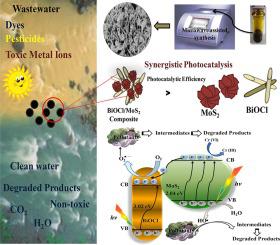FlatChem ( IF 6.2 ) Pub Date : 2021-07-06 , DOI: 10.1016/j.flatc.2021.100267 Divya Monga 1 , Soumen Basu 1

|
Visible light-driven photocatalytic degradation is one of the promising ways to deal with the major problem of water pollution. This study involves one-step, fast, in-situ preparation of BiOCl/MoS2 (2D/2D) heterostructure via microwave irradiations. The photocatalytic performance of BiOCl/MoS2 composite with different weight ratios (1:1, 3:1, and 1:3) have been evaluated for degradation of organic (methylene blue (MB) dye, fipronil pesticide) and inorganic pollutants (Cr(VI)) along with real industrial wastewater under visible light irradiation. XRD, XPS, FESEM, HRTEM, and SAED analysis indicate the formation of single-crystalline nanorods with a high aspect ratio of 1:10. The composites possess high surface area (~40 m2/g) with lower charge recombination and high visible light absorption tendency due to lower band gap (2.30 eV) energy. The high synergistic interaction (~2.29) between BiOCl and MoS2 results in enhancement of degradation activity which shows 94%, 89%, and 90% removal of MB, fipronil, and Cr(VI) metal, respectively by BiOCl/MoS2 (1:3) catalyst. The optimum conditions to get maximum degradation efficiency were determined by varying different reaction parameters like pH, catalyst dose, and illumination area. Radical trapping experiments indicate that holes and hydroxyl radicals had a dominant role in the degradation process. The catalyst is highly stable and reusable as confirmed by the reusability studies. The photocatalytic treatment of industrial wastewater without any physico-chemical pretreatment showed 75% COD and 63% TOC removal under visible light, which indicates high practical efficiency of the catalyst. The current study validates that the BiOCl/MoS2 composites with superior characteristic properties can be efficiently used for wastewater treatment under natural light.
中文翻译:

用二维 MoS 2纳米片装饰的单晶二维 BiOCl 纳米棒用于可见光驱动的有机和无机污染物的光催化解毒
可见光驱动的光催化降解是解决水污染主要问题的一种有前景的方法。本研究涉及通过微波辐射一步、快速、原位制备 BiOCl/MoS 2 (2D/2D) 异质结构。已经评估了不同重量比(1:1、3:1 和 1:3)的 BiOCl/MoS 2复合材料的光催化性能,用于降解有机(亚甲蓝(MB)染料、氟虫腈农药)和无机污染物(Cr (VI)) 以及在可见光照射下的真实工业废水。XRD、XPS、FESEM、HRTEM 和 SAED 分析表明形成了具有 1:10 高纵横比的单晶纳米棒。复合材料具有高表面积(~40 m 2/g) 由于较低的带隙 (2.30 eV) 能量而具有较低的电荷复合和较高的可见光吸收趋势。BiOCl 和 MoS 2之间的高协同相互作用 (~2.29)导致降解活性增强,表明 BiOCl/MoS 2分别去除了 94%、89% 和 90% 的 MB、氟虫腈和 Cr(VI) 金属(1:3) 催化剂。通过改变不同的反应参数(如 pH 值、催化剂剂量和光照面积)来确定获得最大降解效率的最佳条件。自由基捕获实验表明空穴和羟基自由基在降解过程中起主导作用。可重复使用性研究证实,该催化剂高度稳定且可重复使用。未经任何物理化学预处理的工业废水光催化处理在可见光下显示出75%的COD和63%的TOC去除率,表明该催化剂具有较高的实用效率。目前的研究证实,具有优异特性的 BiOCl/MoS 2复合材料可以有效地用于自然光下的废水处理。



























 京公网安备 11010802027423号
京公网安备 11010802027423号